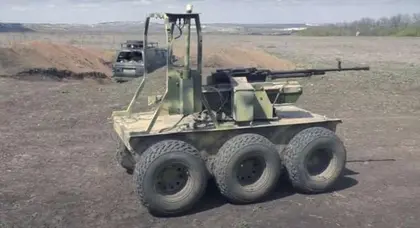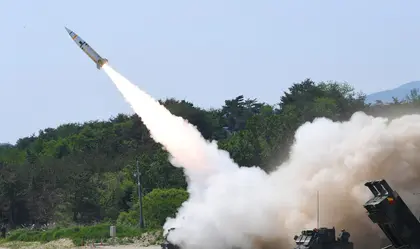In response to its latest battlefield challenges, such as Russian minefields, tank traps and concrete bunkers in the occupied south, Ukraine continues to innovate with new battlefield technology.
Earlier this week, Ukraine’s Deputy Defense Minister Volodymyr Gavrylov revealed that the country is now prioritizing the creation of “battle robots” – or unmanned logistics platforms for evacuating injured troops. A video of the prototype robots was released.
This comes as Ukrainian forces, having liberated around 200 plus square kilometers and nine villages ahead of the so-called Surovikin Line of Russian defense fortifications, tries to advance through the next strata of artillery “kill boxes” and elaborate fortifications en route to occupied Melitopol, Berdyansk and Mariupol.
Prioritizing the preservation of human life, such as through improved rescue and evacuation using robots, is aligned with the military doctrine of the Armed Forces of Ukraine (AFU) – and the subject of criticism of the “you’re going too slow” Western commentators.
To that end, development of unmanned ground vehicles (UGVs) capable of carrying weapon systems would be given secondary priority, Minister Gavrylov said, speaking at a press conference with Ukrainian publisher Industrial Portal.
Such combat-style UGVs could carry automatic grenade launchers, machine guns or anti-tank weapons, and be controlled by operators to hit targets from ambushes or from artificial cover.

ISW Russian Offensive Campaign Assessment, July 25, 2024
Gavrylov continued that the development of stationary ground vehicles armed with machine guns or optical stations for defensive purposes will also be considered as a third priority. Such systems would be immobile but would be controlled by an operator from a different location.
Ukraine’s moves to expand its operational use of “robotic dogs of war” is at the leading edge of military practice.
“Modern UGVs can accomplish a wide variety of missions, from direct fire support to chemical, biological, radiological, and nuclear (CBRN) defense to intelligence, surveillance, and reconnaissance (ISR),” an April analysis by the Center for Strategic and International Studies (CSIS) said.
“In sufficient numbers, UGVs could create meaningful effects and provide useful lessons learned to inform future U.S. and allied efforts beyond just casualty evacuation and explosive ordnance disposal (EOD),” CSIS added.
Ukraine’s emphasis on UGVs is potentially not only pragmatic against an enemy with advantages in infantry fighting vehicles and air power, but also emboldened by past achievements in war by remote control.
To date, Ukraine has already achieved significant successes using UAVs (unmanned aerial vehicles) or airborne drones to target Russian tanks since the start of its offensive in June. In that period, more than 40 percent of Russian losses have been the result of Ukrainian FPV (first person view) UAV attacks.
However, as one expert recently said: “Drones do a lot more than fly.”
Kyiv is also developing the world’s first full fleet of USVs (unmanned surface vessels) or naval drones and is believed to have achieved significant outcomes with them, including neutralizing the Makarov battleship, damaging the Kerch Bridge and making incursions into the port of Sebastopol, which is the home port of the Russian Black Sea fleet.
Late last year, autonomous systems manufacturer Estonian firm Milrem Robotics and German firm Krauss-Maffei Wegmann were contracted by the German Ministry of Defense to deliver 14 THeMIS unmanned ground vehicles to Ukraine.
Of the 14 vehicles, it was reported that seven were to be configured for casualty evacuation and are scheduled to be delivered by the end of this year. The other seven, to be delivered in the second quarter of 2024, were to be configured for route clearance with payloads.
“Casualty evacuation and route clearance are two labor-intensive activities that require the engagement of several people who remain in constant threat of enemy fire,” explained a representative of the manufacturers.
“Automating these tasks with unmanned vehicles alleviates that danger and allows more soldiers to stay in a safe area or be tasked for more important activities.”
The country has also reportedly tested domestically produced RSVK-M2 HUNTER unmanned ground vehicles in eastern Ukraine.
There are more than 30 known types of UGVs for different applications and in a wide variety of sizes and technological configurations produced by the US and its allies. This trend doesn’t simply foretell the future of warfare – it’s a current reality in Ukraine.
“Ukrainian forces are protecting a wide front and are currently engaged in vicious trench warfare with Russian forces and private military corporations like the Wagner Group,” CSIS recently wrote.
“Armed UGVs would help Ukrainian forces engage and suppress Russian infantry while reducing casualties on the Ukrainian side.”
You can also highlight the text and press Ctrl + Enter






